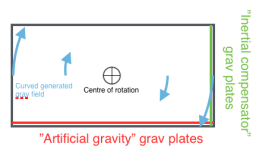Neither the centripetal force nor the lateral displacement from the rotation are in the direction of the main drive (though the latter is, in this example, momentary).That's not lateral (sideways) acceleration, that's rotational acceleration.
Lateral acceleration is linear acceleration to the side, i.e. not in the direction of the main drive.
The net effect on the ship isn't lateral acceleration, but the local effects at a distance from the center of mass, are definitely lateral (and would need to be addressed by an inertial compensation system).

